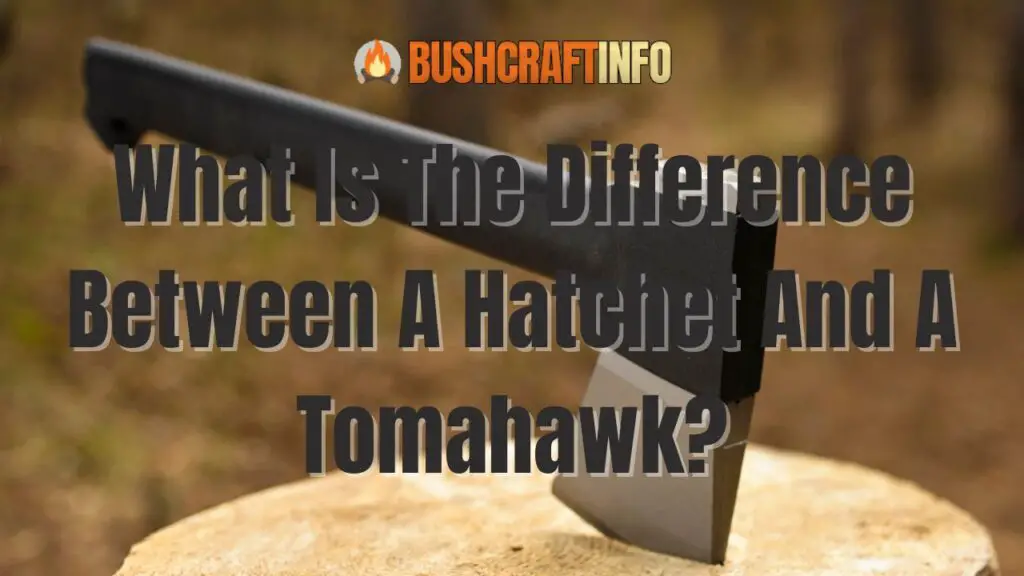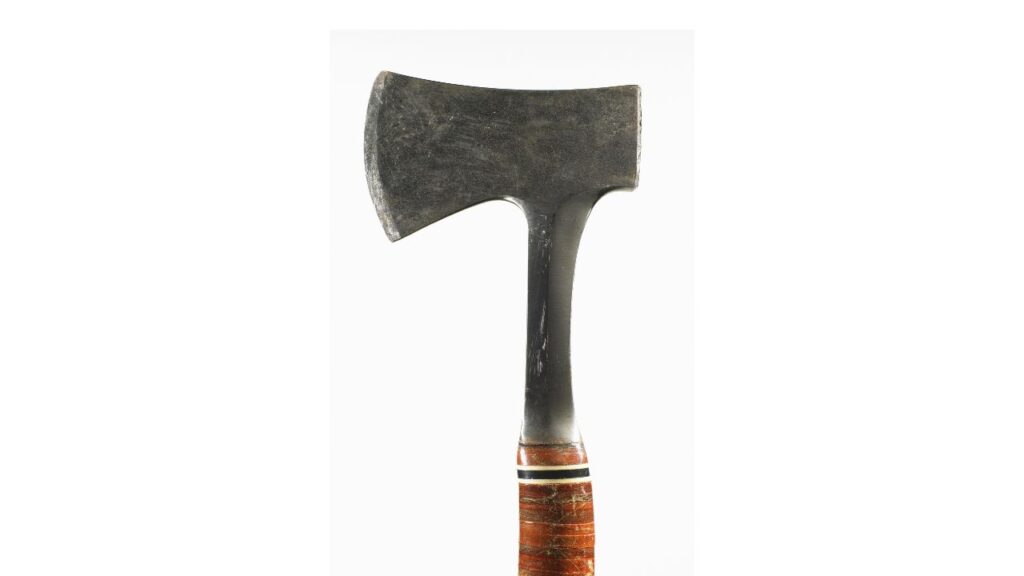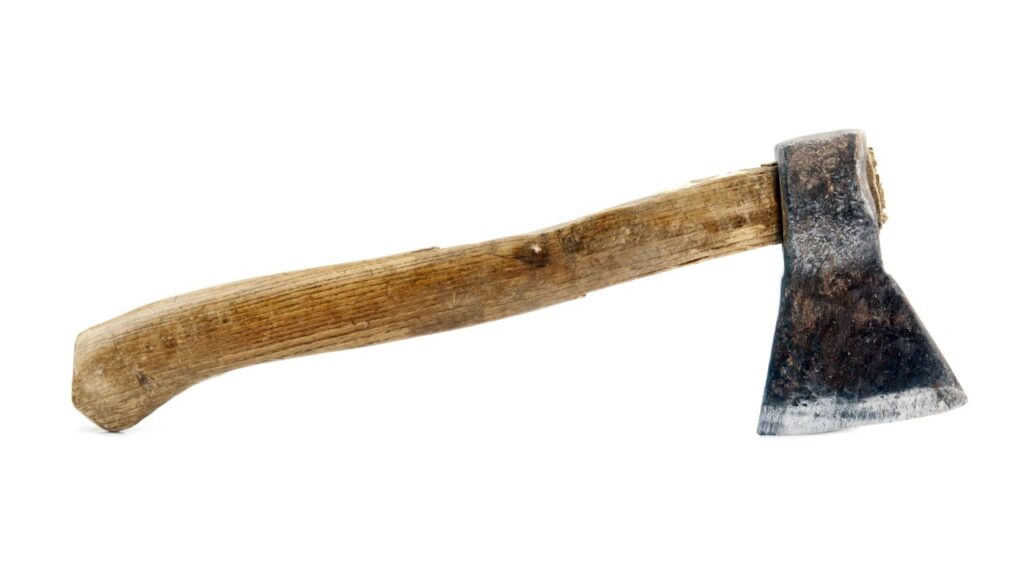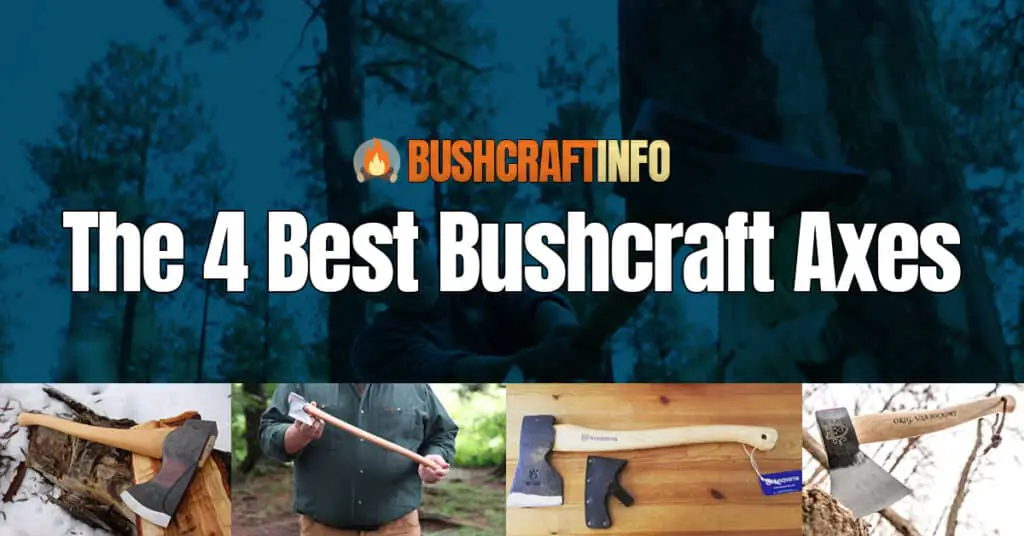Are you interested in knowing what the difference is between a hatchet and a tomahawk?
Hatchets are smaller than tomahawks and have a hammerhead on one side of the blade and a sharp cutting edge on the other side. Tomahawks are larger than hatchets, and they usually only have a sharp cutting edge on one side of the blade.
Both hatchets and tomahawks can be used for chopping wood, but tomahawks are better suited for this task because of their size and weight. Hatchets are also known as hand axes, and they have been used since the Stone Age.
In this article, we will talk about the similarities and differences between a hatchet and a tomahawk and will try to understand where each tool is best suited.
So without wasting any time let’s get into it!

Is There A Difference Between A Tomahawk And A Hatchet?
The first question that comes into mind is whether there is any difference between a tomahawk and a hatchet?
The answer is yes, there is a difference between the two. Hatchets are smaller than tomahawks and have a less tapered head. Tomahawks are larger than hatchets, and they usually only have a sharp cutting edge and a severely tapered head.
Both tools can be used for survival and bushcraft situations. However, both of them have slightly different applications.
What Is A Hatchet?

A hatchet is a small hand axe that is used for chopping wood or other materials. The term “hatchet” can also refer to a larger axe that is used with two hands. Hatchets have been used since the Stone Age and are still used today for a variety of tasks.
The head of a hatchet is usually made of metal, and the handle is usually made of wood. The head of a hatchet is attached to the handle with a piece of leather or rawhide.
Hatchet heads are about 4 inches (10 cm) long and 2 inches (5 cm) wide. Its handles of are about 12 inches (30 cm) long.
What Is A Tomahawk?

A tomahawk is a type of axe that is used as a tool or weapon. Tomahawks were originally created by Native Americans and were later adopted by European settlers.
Tomahawks are usually about 16 inches (40 cm) long and have very thin heads. The head of a tomahawk is also attached to the handle with a strip of rawhide or leather.
The word “tomahawk” comes from the Algonquian word otomahuk which means “to knock down”. Tomahawks are easy to carry and serve as a multi-purpose tool that soldiers in the past used to carry as a secondary weapon too!
What is the Difference Between a Hatchet and a Tomahawk?
So far, you’ve learned about both tools in detail. You might still be wondering what are the main points that make a hatchet different from a tomahawk.
Below are some of the main factors that differentiate the two tools from each other. It will help you understand which one is better suited for your needs too!
If you need a larger tool that can be used as both a weapon and a tool, then a tomahawk is the better option.
Here are some of the main differences between a hatchet and a tomahawk:
Size:
Hatchets are smaller than tomahawks. Hatchets have a head that is about 4 inches (10 cm) long and 2 inches (5 cm) wide. The handle of a hatchet is about 12 inches (30 cm) long. Tomahawks are larger than hatchets. Tomahawks have a head that is about 16 inches (40 cm) long.
Shape:
Hatchets have a more rectangular head while tomahawks have a more tapered head. This helps tomahawks penetrate surfaces more easily. On the other hand side, the head of the hatchet can help you in nailing the tent or any other things.
Weight:
Hatchets are lighter than tomahawks because of their smaller size. This makes them easier to carry and use for extended periods of time. Besides that they are less tiring to use for an extended period of time.
Purpose:
Hatchets are primarily used as a tool for cutting tree branches. Tomahawks can be used as both a tool and a weapon. There is no issue in using both tools in the wilderness, such as bushcraft or survival situations. However, a tomahawk is better suited for tough situations due to its multipurpose usage.
Edge:
Hatchets have a cutting edge on one side of the head while tomahawks usually have a cutting edge on one side a sharp pointy end on the other side. This sharp pointy end can be used for piercing or throwing.
As you can see, there are some key differences between hatchets and tomahawks. Both tools have their own unique purpose and are useful in different situations.
What Are The Different Types Of Materials Used In Hatchets?
Hatchets can be made out of different materials. The most common materials used to make a hatchet are:
Metal:
Metal is the most common material used to make the head of a hatchet. The head of a metal hatchet is usually made out of steel, iron, or aluminum. The most common metal used for making hatchets is carbon steel. It is because it allows being sharpened and forged easily.
Wood:
Wood is the most common material used to make the handle of a hatchet. The wood used for hatchet handles is usually hardwood such as oak, maple, or hickory.
Apart from that, the handle of a hatchet can also be made of other materials, such as fiberglass or plastic. Hatchets can also be made out of other materials, such as stone, bone, or even horn. However, these materials are not as common as metal or wood.
Leather or rawhide:
Leather or rawhide is used to attach the head of a hatchet to the handle. It is used to secure the head of the hatchet so that it does not come off while in use.
What are Different Types of Hatchets?
There are different types of hatchets available depending on their use. The most common types of hatchets are:
Splitting mauls:
Splitting mauls are hatchets that have a blunt end and a sharpened edge. The blunt end is used for striking a wedge into the wood. The sharpened edge is used for splitting the wood along the grain.
Felling axes:
Felling axes are hatchets that have a sharpened edge on one side and a blunt end on the other side. The sharpened edge is used for cutting down trees. The blunt end is used for chopping through the tree trunk.
Camping hatchets:
Camping hatchets are hatchets that are small and lightweight. They are easy to carry and are ideal for chopping wood in campsites. Apart from that, they have a flat head that can be used as a hammer when nailing the tent pegs or batoning wood.
Bushcraft hatchets:
Bushcraft hatchets are similar to camping hatchets, but they are usually larger and heavier. They are designed for more strenuous activities like chopping down trees.
What are the Different Parts of a Hatchet?
The different parts of a hatchet are:
Head: The head is the heavy metal part of the hatchet that contains the blade.
Blade: The blade is the sharpened edge of the head that is used for cutting.
Handle: The handle is the wooden part of the hatchet that is used for gripping.
Butt: The butt is the end of the handle that is used for striking.
What are the Different Types of Tomahawks?
Just like hatchets, there are different types of tomahawks available depending on their use. The most common types of tomahawks are:
Throwing tomahawks:
Throwing tomahawks are small and lightweight with a sharp point on one end and a cutting edge end on the other. They are designed for throwing at targets. Both the pointed edge and the cutting edge and sharp enough to hit the target.
Combat tomahawks:
Combat tomahawks are larger and heavier than throwing tomahawks. They usually have a sharp blade on one side and a blunt hammerhead on the other. Apart from that, some combat tomahawks have a sharp pointy pike on top too. They are designed for close-quarters combat.
Camping tomahawks:
Camping tomahawks are similar to hatchets and are designed for chopping wood on campsites. Most camping tomahawks comes with blunt and squared head on one side. It allows the user to use the tool like a hammer just like a hatchet.
What are the Different Parts of a Tomahawk?
The different parts of a tomahawk are:
Head: The head is the metal part of the tomahawk that contains the blade.
Blade: The blade is the sharpened edge of the head that is used for cutting.
Handle: The handle is the wooden or metal part of the tomahawk that is used for gripping.
Spike: The spike is the sharp point on the opposite end of the blade that is used for piercing.
Hammerhead: The hammerhead is the blunt end on the opposite side of the spike that is used for striking.
As you can see, hatchets and tomahawks are both versatile tools that can be used for a variety of purposes.
Whether you need to chop wood for a campfire or defend yourself in a close-quarters combat situation, one of these tools will come in handy. So, make sure to add a hatchet or tomahawk to your survival gear list.
Can A Tomahawk Chop Wood?
You may be wondering if a tomahawk can chop wood since it is primarily used as a weapon.
The answer is yes, a tomahawk can be used to chop wood. The extra length of the handle provides it an advantage as it allows the tool to generate more momentum. Thus, a tomahawk can be used to chop wood easily.
Tomahawks are better suited for chopping through smaller pieces of wood or for chopping through tough surfaces. If you need to chop a lot of wood, then a hatchet is the better option.
However, people use hatchets more often when it comes to cutting down tree branches. This is because they are smaller in size and allows the user to have more control over the tool.
What Makes A Tomahawk A Tomahawk?
Another question you might have is what makes a tomahawk a tomahawk?
The main thing that makes a tomahawk a tomahawk is the shape of its head. Besides that, the size of a tomahawk is also different than the size of a hatchet or any other type of axe.
Tomahawks have a long and thin head that is attached to the handle with a strip of rawhide or leather. The head of a tomahawk is also usually tapered, which helps it penetrate surfaces more easily.
What Are The Pros And Cons Of A Hatchet?
After reading all the above information, you might be interested in learning about the pros and cons of both tools. This will help you make a better decision according to your needs.
Let’s Start With The Pros Of A Hatchet First:
- Hatchets are smaller and lighter than tomahawks which makes them easier to carry and use.
- Hatchets have a more rectangular head which is better for chopping wood.
- Hatchets are less expensive than tomahawks.
- The backside of a hatchet’s head can be used as a hammer
- They are easy to use and provide excellent results in clearing bushes and cutting branches
And Now For The Cons Of A Hatchet:
- A hatchet requires more power to use on tougher surfaces.
- Due to its lightweight and smaller size, it requires more torque to generate power
- A hatchet is not as versatile as a tomahawk
What Are The Pros And Cons Of A Tomahawk?
Tomahawks have many of the same pros as hatchets, but they also have some unique pros of their own.
- The main pro of a tomahawk is that it can be used as both a tool and a weapon. This makes it a very versatile tool to have in the wilderness.
- Another pro of a tomahawk is that it has a sharp pointy end that can be used for piercing or throwing.
And Now For The Cons Of A Tomahawk:
- Tomahawks are larger and than hatchets
- Tomahawks are more expensive than hatchets.
- The head of a tomahawk is not as well suited for hammering.
Tomahawk vs Hatchet: Which one Does More damage?
The main thing that most people might be interested to know is which one does more damage. As a general rule of thumb, a tool with a longer handle will be able to generate more momentum.
As a result, it will much more damage as compared with the tool that features a shorter handle.
Keeping this in mind, the Tomahawk does much more damage than the hatchet. It is because the extra handle length provides it an advantage in terms of generating more momentum.
This is the main reason why Tomahawks are primarily used as weapons while hatchets are used as tools.
Is A Tomahawk A Good Weapon?
The answer to this question is yes, a tomahawk is a good weapon. The main reason for this is that it can generate a lot of force due to its long handle.
This makes it very effective at piercing or throwing. Tomahawks are also very light and easy to carry, which makes them a good option for self-defense.
How Sharp Is A Hatchet?
Hatchets are generally very sharp. The main reason for this is that they need to be able to chop through wood easily.
The sharpness of a hatchet can also be increased by honing it with a whetstone. In order to test the sharpness of your hatchet, you can conduct a thumbnail test or a paper cutting test.
So, Which One Should You Choose?
Now that you know the key differences between hatchets and tomahawks, you can make a better decision about which one is right for you.
If you need a tool primarily for chopping wood, then a hatchet is the better option. But if you need a versatile tool that can be used for both chopping wood and as a weapon, then a tomahawk is the better choice.
Apart from that, if you are looking for a tool that requires less space then you will have to go for a hatchet due to its smaller size.
Last Minute Thoughts
So what is the difference between a hatchet and a tomahawk? Well, the first and the most noticeable difference between the two tools is the size. As mentioned, tomahawks are larger in size as compared to hatchets.
Apart from that, hatchets are more lightweight as compared to tomahawks and allow them to be carried easily in any kind of terrain. Tomahawks, on the other hand, are more versatile and can be used both as a tool and a weapon, making them a perfect choice for survivalists and preppers.
So, that sums up the key difference between hatchets and tomahawks. I hope this article helped you gain a better understanding of these two tools. If you have any questions, please feel free to leave them in the comment section below and I will be more than happy to answer them for you.
Was this post helpful?

Hey I’m Josh! I have been practicing Bushcraft for a little over 6 years now! I Started this website to review awesome bushcraft gear that I love as well as share information I have learned along the way!



